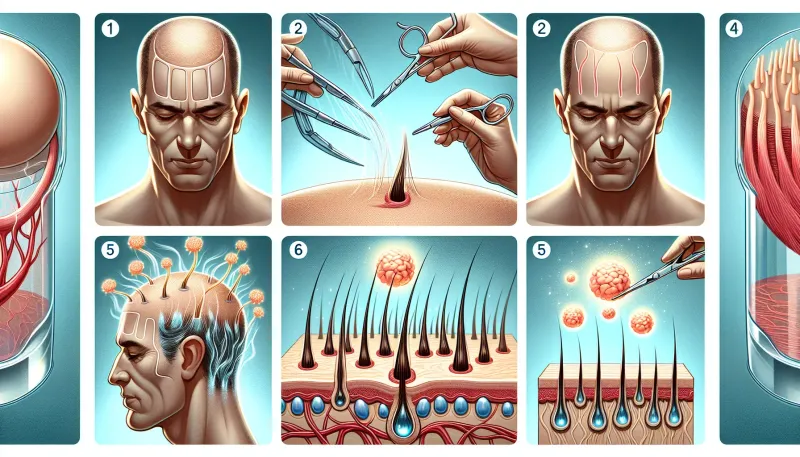Top 5 Hair Loss Surgery Options: What You Need to Know

Discover the top 5 hair loss surgery options available today. Learn about the benefits, risks, and what to expect from each procedure to make an informed decision.
Losing hair can be a distressing experience, but fortunately, there are several surgical options available to help restore a fuller head of hair. Hair loss surgery options have evolved over the years, offering more effective and less invasive solutions. This article provides an in-depth look at the top five hair loss surgery options, their benefits, risks, and what you can expect from each procedure.
1. Follicular Unit Transplantation (FUT)
Overview
Follicular Unit Transplantation (FUT) is one of the most established and widely used hair transplant techniques. In this method, a strip of skin containing hair follicles is removed from the donor area, typically the back of the scalp, and then dissected into individual follicular units for transplantation to the thinning or balding areas.
Benefits
- High survival rate of transplanted follicles
- Suitable for large areas of hair loss
- A single session can transplant thousands of follicles
Risks
- Linear scar at the donor site
- Longer recovery time compared to other methods
- Possible swelling and discomfort
What to Expect
After the procedure, patients may need to take time off work to recover. Swelling and discomfort are common, and a linear scar will remain at the donor site, which can be covered by surrounding hair. Results typically start to become noticeable after 6 to 9 months.
2. Follicular Unit Extraction (FUE)
Overview
Follicular Unit Extraction (FUE) is a less invasive alternative to FUT. Individual hair follicles are extracted directly from the donor area and implanted into the thinning or balding regions. This method avoids the need for a linear incision, resulting in minimal scarring.
Benefits
- Minimally invasive with no linear scar
- Quicker recovery time
- Suitable for patients who prefer to wear their hair short
Risks
- Requires shaving of the donor area
- Longer procedure time
- Potential for low graft survival rate if performed by inexperienced practitioners
What to Expect
Recovery from FUE is typically faster than FUT, with most patients returning to normal activities within a few days. Minor redness and swelling may occur, but these usually subside within a week. New hair growth can be expected within 3 to 4 months, with full results visible after about a year.
3. Robotic Hair Transplantation
Overview
Robotic hair transplantation leverages advanced robotics technology to assist in the precision extraction and implantation of hair follicles. The ARTAS system is one of the most recognized robotic systems used in this procedure, enhancing accuracy and consistency.
Benefits
- High precision and accuracy
- Minimally invasive with minimal scarring
- Consistent results
Risks
- High cost due to advanced technology
- Requires highly trained personnel to operate the system
- Potential for technical malfunctions
What to Expect
Robotic hair transplantation offers a smooth recovery process, with most patients experiencing minimal discomfort and returning to their routines within a week. The precision of the robotic system ensures a natural-looking hairline, and results will become noticeable around 6 months post-procedure, with full growth seen by 12 to 18 months.
4. Platelet-Rich Plasma (PRP) Therapy
Overview
Platelet-Rich Plasma (PRP) therapy is a non-surgical treatment that involves injecting concentrated platelets derived from the patient's own blood into the scalp. These platelets release growth factors that stimulate hair growth and improve hair thickness.
Benefits
- Non-surgical and minimally invasive
- Uses the patient's own blood, reducing risk of allergic reactions
- Can enhance the results of hair transplant surgery
Risks
- Multiple sessions required
- Results may vary depending on individual response
- Temporary soreness and swelling
What to Expect
PRP therapy is a quick outpatient procedure with minimal downtime. Mild soreness and swelling at the injection site may occur, but these symptoms typically subside within a day. Patients usually undergo multiple sessions spaced a few weeks apart, and early results can be seen within a few months.
5. Scalp Reduction Surgery
Overview
Scalp reduction surgery involves removing a bald section of the scalp and stretching the surrounding hair-bearing areas to cover the excised area. This technique is less commonly used today due to the development of more advanced hair transplant methods but can be effective for specific cases.
Benefits
- Reduces the bald area size significantly
- Can be combined with hair transplantation for enhanced results
Risks
- Invasive with significant recovery time
- Potential for scarring and complications
- May require multiple surgeries
What to Expect
Scalp reduction surgery is an invasive procedure that requires a longer recovery period. Patients need to take special care of the scalp post-surgery and may experience significant discomfort. Results depend on the extent of baldness and the elasticity of the scalp but can be quite effective in reducing large bald areas.
Conclusion
Choosing the right hair loss surgery option depends on various factors, including the extent of hair loss, patient preferences, and the expertise of the surgeon. While each method has its own set of benefits and risks, consulting with a qualified hair restoration specialist is crucial to determine the best approach for your individual needs. With the advancements in hair restoration techniques, regaining a fuller head of hair is more achievable than ever before.



























